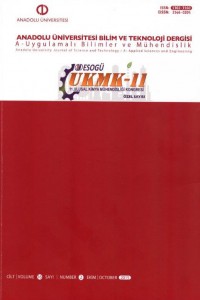Öz
In this study, wet brick samples with different clay contents (40, 50 and 60%) were dried at various drying air temperatures (50, 60and 70 oC) and velocities (1.13; 1.52; 1.66 m/s) in a laboratory scale tunnel dryer. The results indicated that increasing air temperature reduces drying time at any clay content of the brick body. Drying times were obtained as 280 and 170 minutes at drying air temperatures of 50 and 70 oC for sample with 40% clay content, respectively. Increasing clay percentage in wet brick body resulted in an increase of the drying time. At drying air conditions (50 oC, 1.13 m/s), the sample with the lowest clay content (40%) had 280 minutes drying time whereas the highest clay content one (60%) had 315 minutes drying time. The drying air temperature also affected sample’s drying shrinkage. Drying air temperatures increased from 50 to 70 oC, total drying shrinkage decreased from 5.90% to 4.89% (40% clay content and 1.13 m/s air velocity), respectively. According to TS 2514, flexure strength has to be at least 1 MPa for dried bricks. When all test results were examined, they had been seen that the flexure strength values were quite higher than 1 MPa
Anahtar Kelimeler
Kaynakça
- ASTM (2007). Standard Test Method for Free Moisture in Ceramic Whiteware Clays, C324-01.
- ASTM (2009). Standard Test Method for Drying and Firing Shrinkages of Ceramic Whiteware Clays, C326−09.
- ASTM (2013). Standard Test Methods for Sampling and Testing Brick and Structural Clay Tile, C67−13a.
- DPT (Devlet Planlama Teşkilatı) (2008). Dokuzuncu Beş Yıllık Kalkınma Planı. Taş ve Toprağa Dayalı Sanayiler Özel İhtisas Komisyonu Raporu, Cilt 1, DPT: 2773 ÖİK: 703, Ankara.
- Geankoplis, C.J. (1993). Transport Processes and Unit Operations. Prentice Hall, Inc., 3rd edition, U.S.A.
- Hasatani, M., Itaya, Y. and Muroie, K. (1993). Contraction Characteristics of Molded Ceramics During Drying. Drying Technology, 11(4) 815-830.
- Kornmann, M. (2007) Clay Bricks and Roof Tiles: Manufacturing and Properties. Société de l'industrie Minérale, France.
- Kowalski, S.J. (2003). Thermomechanics of Drying Processes. Vol. 8, Springer.
- Kowalski, S.J., Musielak, G. and Banaszak, J. (2007). Experimental Validation of The Heat and Mass Transfer Model for Convective Drying, Drying Technology, 25, 107-121.
- Kowalski, S.J., Musielak, G. and Rybick, A. (1997). The Response of Dried Materials to Drying Conditions. Int. J. Heat and Mass Transfer, Vol:40, No:5 1217-1226.
- TS 2514 (1977). Kerpiç Bloklar Yapım ve Kullanma.
- Vellhuis, J.M. and Denissen, J. (1997). Simulation Model for Industrial Dryers: Reduction of Drying Times of Ceramics & Saving Energy. Drying Technology, 15(6-8), 1941-1949.
Öz
ÖZ
Bu çalışmada, kil içeriği farklı (%40, 50 ve 60) yaş tuğla numuneleri laboratuvar ölçekli tünel kurutucuda farklı kurutma havası sıcaklıkları (50, 60ve 70 oC) ve hızlarında (1,13; 1,52; 1,66 m/s) kurutulmuştur. Deney sonuçları incelendiğinde, herhangi bir kil içeriğine sahip numunelerde kurutma havası sıcaklığı artışıyla kuruma süresinin azaldığı görülmüştür. Kil içeriği %40 olan numune için kurutma havası sıcaklığı 50 oC’de kuruma süresi 280 dakika, 70 oC’de ise 170 dakika olarak ölçülmüştür. Numune kil yüzdesi artışıyla kurutma süresinin arttığı görülmüştür. Kurutma havası sıcaklığı 50 oC ve hızı 1,13 m/s olduğu koşulda en düşük kil (%40) içerikli numunenin kuruma süresi 280 dakika iken en yüksek kil (%60) içerikli numuneninki 315 dakika olarak belirlenmiştir. Kurutma havası sıcaklığı numune kuruma küçülmesini etkilemiştir. Kurutma havası hızı 1,13 m/s iken kil içeriği %40 olan numune, 50 °C’de kurutulduğunda toplam kuruma küçülmesi %5,90, 70 °C’de ise %4,89 olarak ölçülmüştür. TS 2514 standardına göre kurutulmuş numunelerin eğilme dayanımı en az 1 MPa olmalıdır. Numunelerin test sonuçları incelendiğinde, tüm kurutma parametreleri için eğilme dayanımlarının 1 MPa’dan yüksek olduğu görülmüştür.
Anahtar Kelimeler
Kaynakça
- ASTM (2007). Standard Test Method for Free Moisture in Ceramic Whiteware Clays, C324-01.
- ASTM (2009). Standard Test Method for Drying and Firing Shrinkages of Ceramic Whiteware Clays, C326−09.
- ASTM (2013). Standard Test Methods for Sampling and Testing Brick and Structural Clay Tile, C67−13a.
- DPT (Devlet Planlama Teşkilatı) (2008). Dokuzuncu Beş Yıllık Kalkınma Planı. Taş ve Toprağa Dayalı Sanayiler Özel İhtisas Komisyonu Raporu, Cilt 1, DPT: 2773 ÖİK: 703, Ankara.
- Geankoplis, C.J. (1993). Transport Processes and Unit Operations. Prentice Hall, Inc., 3rd edition, U.S.A.
- Hasatani, M., Itaya, Y. and Muroie, K. (1993). Contraction Characteristics of Molded Ceramics During Drying. Drying Technology, 11(4) 815-830.
- Kornmann, M. (2007) Clay Bricks and Roof Tiles: Manufacturing and Properties. Société de l'industrie Minérale, France.
- Kowalski, S.J. (2003). Thermomechanics of Drying Processes. Vol. 8, Springer.
- Kowalski, S.J., Musielak, G. and Banaszak, J. (2007). Experimental Validation of The Heat and Mass Transfer Model for Convective Drying, Drying Technology, 25, 107-121.
- Kowalski, S.J., Musielak, G. and Rybick, A. (1997). The Response of Dried Materials to Drying Conditions. Int. J. Heat and Mass Transfer, Vol:40, No:5 1217-1226.
- TS 2514 (1977). Kerpiç Bloklar Yapım ve Kullanma.
- Vellhuis, J.M. and Denissen, J. (1997). Simulation Model for Industrial Dryers: Reduction of Drying Times of Ceramics & Saving Energy. Drying Technology, 15(6-8), 1941-1949.
Ayrıntılar
| Birincil Dil | Türkçe |
|---|---|
| Bölüm | Araştırma Makalesi |
| Yazarlar | |
| Yayımlanma Tarihi | 18 Kasım 2015 |
| Yayımlandığı Sayı | Yıl 2015 Cilt: 16 Sayı: 2 |


